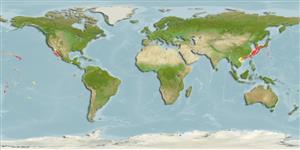Teleostei (teleosts) >
Perciformes/Serranoidei (Groupers) >
Anthiadidae (Fairy basslets or Streamer basses)
Etymology: Plectranthias: Greek, plektron = anyhting to strike with, spur + Greek, anthias = a fish, Sparus aurata (Ref. 45335).
Eponymy: Takeshi Yamakawa (d: 1942) is a fish collecting specialist who is an ichthyologist at Kochi University (Japan). [...] (Ref. 128868), visit book page.
Environment: milieu / climate zone / depth range / distribution range
Ecology
Marine; demersal; depth range ? - 200 m (Ref. 26833). Tropical
Western Pacific.
Size / Weight / Age
Maturity: Lm ? range ? - ? cm
Max length : 20.0 cm SL male/unsexed; (Ref. 559)
Dorsal spines (total): 10; Dorsal soft rays (total): 17; Anal spines: 3; Anal soft rays: 7; Vertebrae: 26. Body reddish yellow above and whitish below, speckled with dark green on upper half of the body when fresh. A large reddish blotch of about eye diameter below lateral line. Ventral, anal and caudal fins yellowish; pectorals reddish. Head thickly scaled except snout, preorbital, lips, both jaws and throat. Cheek with 7 rows of scales. Mouth large, oblique and protractile; lower jaw slightly protruded when closed. Maxillary extends to below the posterior border of pupil.
Found over rocky bottom.
Life cycle and mating behavior
Maturity | Reproduction | Spawning | Eggs | Fecundity | Larvae
Randall, J.E., 1980. Revision of the fish genus Plectranthias (Serranidae: Anthiinae) with description of 13 new species. Micronesia 16(1):101-187. (Ref. 8944)
IUCN Red List Status (Ref. 130435: Version 2024-1)
Threat to humans
Harmless
Human uses
Fisheries: commercial
Tools
Special reports
Download XML
Internet sources
Estimates based on models
Preferred temperature (Ref.
123201): 14.7 - 22.4, mean 18.8 °C (based on 107 cells).
Phylogenetic diversity index (Ref.
82804): PD
50 = 0.5000 [Uniqueness, from 0.5 = low to 2.0 = high].
Bayesian length-weight: a=0.02512 (0.00987 - 0.06393), b=2.97 (2.74 - 3.20), in cm total length, based on LWR estimates for this (Sub)family-body shape (Ref.
93245).
Trophic level (Ref.
69278): 4.0 ±0.67 se; based on food items.
Resilience (Ref.
120179): Medium, minimum population doubling time 1.4 - 4.4 years (Preliminary K or Fecundity.).
Fishing Vulnerability (Ref.
59153): Low vulnerability (14 of 100).
